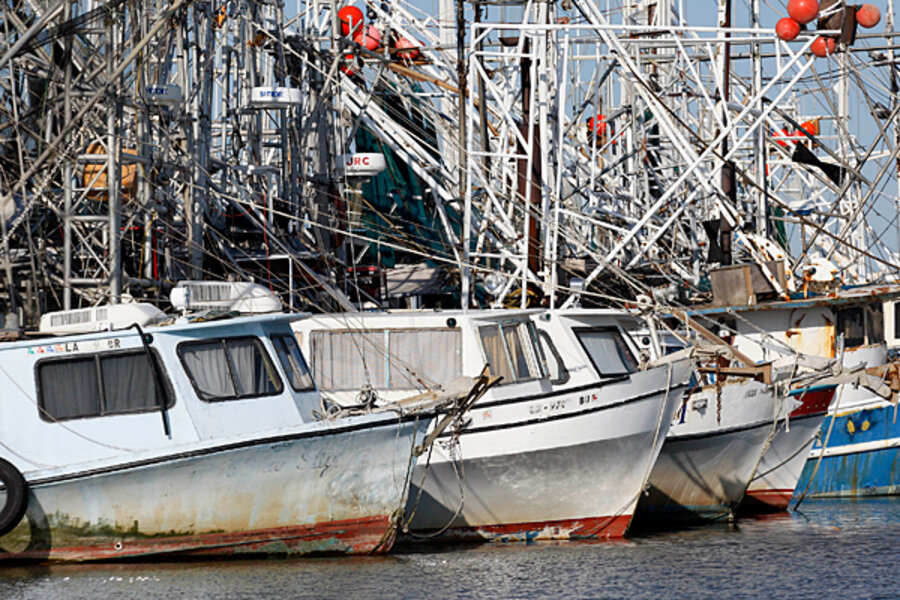Oil spill: What is the threat to Gulf of Mexico seafood?
Loading...
Along with officials' consistently cautious predictions about the scope of the Gulf of Mexico oil spill, another group has been calling for a tempering of dire oil-spill forecasts: the Gulf of Mexico seafood industry.
Already battered by imports of shrimp and other seafood – 80 percent of the seafood Americans eat is imported – the Gulf of Mexico seafood industry is eager to avoid a panic about the safety of their catch. And for good reason.
So far, the seafood is safe. Gulf oysters are never exposed to surface waters, so unless the oil sinks, the oysters could well survive, as could shrimp and stocks of redfish and other species who can swim away from the spill.
IN PICTURES: Louisiana oil spill
But in the longer term, the spill could pose a significant danger to the industry if it damages fragile nursery grounds or drips down into oyster beds.
"If you talk about the sky falling too early, then people stop buying Louisiana oysters, blue crabs, and shrimp, and since we're talking about people's livelihoods you have to be very, very careful about saying things that will get dispersed around the world," says Ed Overton, an emeritus professor of environmental science at Louisiana State University. "On the other hand, they won't get a paycheck if there's no oysters."
Cautious predictions
The massive and expanding oil slick is now nosing up to the Gulf Coast shoreline. But at first, officials said the well wasn't leaking after the Deepwater Horizon oil rig exploded, burned and then sank. Then they underestimated by a factor of five the amount of oil that was spewing from the well – now saying that it is not 1,000 barrels a day, as previously thought, but 5,000.
Even as globs of oil and mousse-like residue are now set to impact the coast, official language remains cautious. "You are getting ahead of yourself a little when you try to speculate and say this is catastrophic. It is premature to say this is catastrophic," said Coast Guard Admiral Mary Landry on Wednesday. "I will say this is very serious."
That language suits the Louisiana seafood industry just fine.
"No one should be worrying about whether the shrimp they're having for dinner is going to have oil on it," Mike Voisin, the past president of the National Fisheries Institute, told CNN earlier this week. "[T]hose areas that have oil in them will be blocked by state health officials and not harvested."
Louisiana's commercial fish industry sells $1.8 billion of product each year, rivaled only by Alaska. The Gulf of Mexico accounts for 40 percent of the seafood that is caught in the lower 48 states and consumed domestically.
Preparing for landfall
Meanwhile, sport fishing produces $1 billion in sales a year, according to Business Week. The impact from the oil spill is already being felt by charter boat captains in places like Venice, La.
“Depending on what happens in the next few days, this could have a relatively small impact on coastal Louisiana or significant long-term effects, including closed fishing areas, oiled wildlife, and worse,” Mark Schexnayder, regional coastal adviser for Louisiana State University, tells Business Week.
Oystermen and shrimpers along the Gulf coast stepped up their trips to haul as much catch as they can before the the slick comes ashore. "We're fighting a losing effort," Louisiana oysterman Mitch Jurasich told the Associated Press.
Louisiana's coastline is 15,000 miles long and holds 3 million acres of wetlands, which nurse speckled trout, red drum, and myriad vaunted game fish. This year's brown shrimp catch is currently growing to size in the marsh inlands. Five million migratory birds also make the area their home for at least part of the year.
"If there is any good news, it's that all of our seafood harvest is below deck, so to speak," says Mr. Overton. "But if the nursery grounds are destroyed, the harvest this year may not be affected, but years out it will. If you destroy food habitat, this just tumbles and tumbles."
IN PICTURES: Louisiana oil spill
Related:
Gulf of Mexico oil spill could be bigger than Exxon Valdez
Oil spill serves as testing ground for futuristic high-tech cleanups





